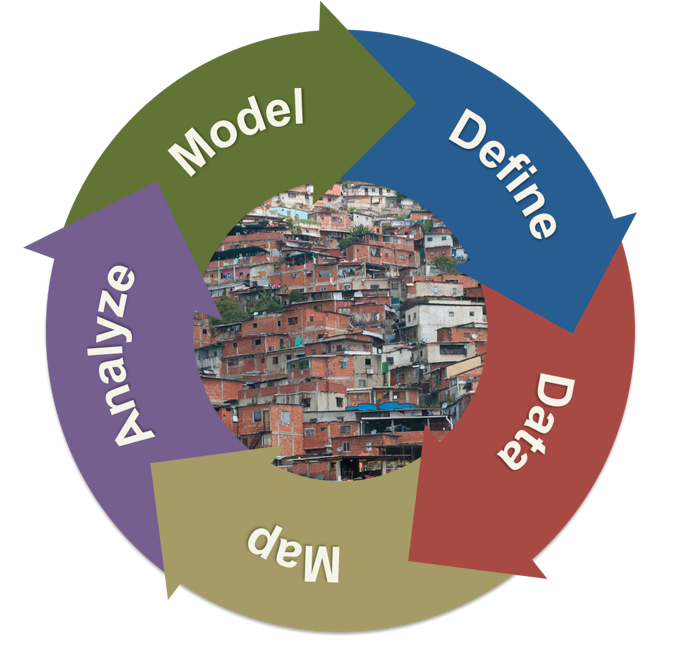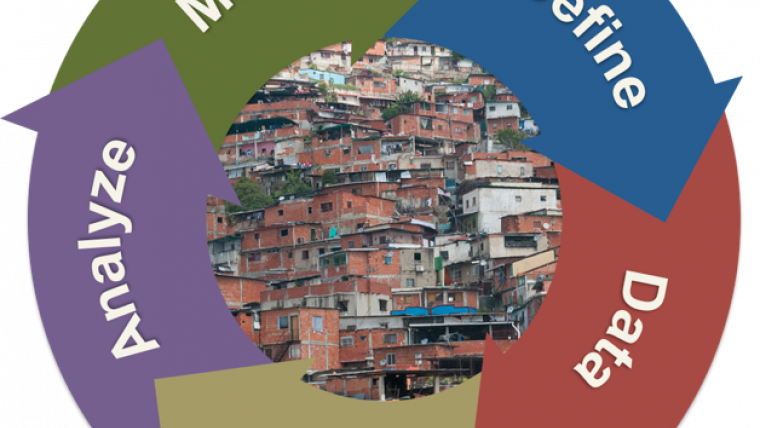Mapping and Monitoring of Slums in 5 Steps
Define, Data, Map, Analyse, Model
Over one billion people currently live in informal settlements (‘slums’) and, with the global population increasing, this number is only expected to grow in the coming decades. These communities are often recognised as the most vulnerable groups in society. In order to better address the plight of slum dwellers (e.g. by providing better infrastructure and services) and develop more effective and efficient policies, it is necessary to collect better information on slums and to monitor slum populations. This article proposes a five-step process for tackling this problem.
The authors of this article have developed a five-step process for data collection and monitoring of slum populations as the basis for addressing the plight of slum dwellers and for more effective and efficient policymaking. The five steps are: define, data, map, analyse and model (DDMAM).
Define
The first step in addressing any problem with slums is to define what they are and at what spatial and temporal scales they are to be monitored. This is a challenging task, with definitions ranging from ‘local’ (e.g. household) to ‘community’ (e.g. settlement) and, further, the national level (e.g. country). No definition will be best suited to addressing all problems of slums, since each contains its own set of unique biases and uncertainties (Mahabir et al. 2016). The definition for slums, however, must consist of a measurable set of characteristics which, when combined, can separate slums from other types of human settlements. For example, UN Habitat suggests that a situation in which more than three people share the same habitable room represents overcrowding – a common characteristic of slum households. Moreover, the definition of slums used must be agreed upon by a good cross section of stakeholders involved at the different spatial scales (e.g. the slum dweller, surrounding communities, local and national governments and non-government organisations such as Slum Dwellers International).

Data
After a definition has been agreed upon, data must then be collected. Data collection should be guided by the definition and adhere to strict quality assurance and control measures. This will minimise bias during data collection, permitting an acceptable level of confidence in the data. Many developed countries (e.g. USA and UK) have extensive documentation addressing quality assurance and control issues in population surveys, which can be used for improving the quality of data collected on slums. Other countries, e.g. India, have developed a quality assurance manual (MHUPA 2014) for accompanying construction works of housing, social amenities and basic civic infrastructure as part of the Rajiv Awas Yojana programme to address the issue of slums. Data for slums should further not be limited to a single source but rather various sources should be used, since slums are a multi-dimensional issue. Examples of data sources include traditional (e.g. census surveys) and remote sensing sources (e.g. satellite and aerial imagery). Newer and emerging data sources such as crowdsourced information should further be investigated and their contribution to slum mapping determined. For example, Crooks et al. (2014) highlight several examples using crowdsourcing to improve the quality of information on urban environments, including the use of social media data such as Flickr tags and text extracted from travel blogs.
Map
Once data is available, it then becomes important to combine the various information in a meaningful way to map the boundaries of slums. Each data source will influence the final slum map to a different extent, and the level of influence is also dependent on the methods selected to combine the data. Several approaches have been adopted in the past to map slums, ranging from participatory (e.g. MapKibera), census data (e.g. Weeks et al. 2007) and remote sensing (e.g. Hofmann et al. 2008). The use of mixed approaches should also be investigated (Mahabir et al. 2018). The selected method, however, should be systematic in its approach. Mapping involves undergoing several iterations where the output of every run of the process is validated against existing data and using stakeholders. Feedback from this process is then used to improve the data and method used for combining them. This is done until an acceptable level of accuracy is achieved.
Analyse
Following this, the analyse stage involves the ongoing monitoring of slums, collecting meaningful statistics (e.g. expansion and growth trajectory) at different time periods and using the findings to gain a better understanding of slums. Knowledge of the different growth stages of slums is important as this will determine the type of interventions required.
Model
Finally, slum maps generated and knowledge gained about slums can then be used as inputs to model slums at different spatial and temporal scales. Modelling approaches (e.g. cellular automata or agent based models (ABMs)) can be used to test different ‘what if’ scenarios, and this is important for assessing the usefulness of different decisions to be used before implementation. Patel et al., (2012), for example, explored the spatiotemporal dynamics of slum formation in Ahmedabad, India, capturing the cross-scale dynamics of several actors (slum households, developers and politicians) known to influence the formation and persistence of slum settlements. The outputs of such models could eventually be used to improve the definition of slums.
Conclusion
These five steps provide the foundation for a more systematic and holistic approach towards the mapping and monitoring of slums.

Value staying current with geomatics?
Stay on the map with our expertly curated newsletters.
We provide educational insights, industry updates, and inspiring stories to help you learn, grow, and reach your full potential in your field. Don't miss out - subscribe today and ensure you're always informed, educated, and inspired.
Choose your newsletter(s)
























